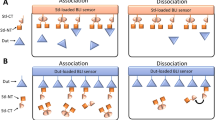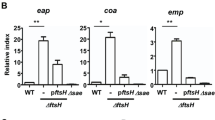Abstract
SarA, a pleiotropic transcription regulator, is encoded by Staphylococcus aureus, a pathogenic bacterium. The expression of many virulence and non-virulence genes in S. aureus is modulated by this regulator. Structural studies have shown it to be a winged-helix DNA-binding protein carrying two monomers. Each SarA monomer is composed of five α-helices (α1–α5), three β-strands (β1–β3) and multiple loops. The putative DNA binding region of SarA is constituted with α3, α4, β2, and β3, whereas, its dimerization seems to occur using α1, α2, and α5. Interestingly, many SarA-like proteins are dimeric and use three or more helices for their dimerization. To clearly understand the roles of helix α1 in the dimerization, we have constructed and purified a SarA mutant (Δα1) that lacks helix α1. Our in-depth studies with Δα1 indicate that the helix α1 is critical for preserving the structure, DNA binding activity and thermodynamic stability of SarA. However, the helix has little affected its dimerization ability. Possible reasons for such anomaly have been discussed at length.







Similar content being viewed by others
Abbreviations
- rSarA:
-
Recombinant SarA
- Δα1:
-
rSarA lacking helix α1
- PCR:
-
Polymerase chain reaction
- IPTG:
-
Isopropyl-β-D-1-thiogalactopyranoside
- PMSF:
-
Phenylmethane sulfonylfluoride
- SDS-PAGE:
-
Sodium dodecyl sulphate polyacrylamide gel electrophoresis
- CD:
-
Circular dichroism
- hla:
-
Promoter region of S. aureus α-toxin-encoding gene
- Ni-NTA:
-
Nickel nitrilotriacetic acid
References
Otto M (2010) Basis of virulence in community-associated methicillin-resistant Staphylococcus aureus. Annu Rev Microbiol 64:143–162
Plata K, Rosato AE, Wegrzyn G (2009) Staphylococcus aureus as an infectious agent: overview of biochemistry and molecular genetics of its pathogenicity. Acta Biochim Pol 56:597–612
Cue D, Lei MG, Lee CY (2012) Genetic regulation of the intercellular adhesion locus in staphylococci. Front Cell Infect Microbiol 2:38
Arya R, Princy SA (2013) An insight into pleiotropic regulators Agr and Sar: molecular probes paving the new way for antivirulent therapy. Future Microbiol 8:1339–1353
Cheung AL, Bayer AS, Zhang G, Gresham H, Xiong YQ (2004) Regulation of virulence determinants in vitro and in vivo in Staphylococcus aureus. FEMS Immunol Med Microbiol 40:1–9
Bronner S, Monteil H, Prévost G (2004) Regulation of virulence determinants in Staphylococcus aureus: complexity and applications. FEMS Microbiol Rev 28:183–200
Dunman PM, Murphy E, Haney S, Palacios D, Tucker-Kellogg G, WU S, Brown EL, Zagusky RJ, Shlaes D, Projan SJ (2001) Transcription profiling-based identification of Staphylococcus aureus genes regulated by the agr and/or sarA loci. J Bacteriol 183:7341–7353
Morrison JM, Anderson KL, Beenken KE, Smeltzer MS, Dunman PM (2012) The staphylococcal accessory regulator, SarA, is an RNA-binding protein that modulates the mRNA turnover properties of late-exponential and stationary phase Staphylococcus aureus cells. Front Cell Infect Microbiol 2:26
Didier JP, Cozzone AJ, Duclos B (2010) Phosphorylation of the virulence regulator SarA modulates its ability to bind DNA in Staphylococcus aureus. FEMS Microbiol Lett 306: 30–36
Sun F, Ding Y, Ji Q, Liang Z, Deng X, Wong CC, Yi C, Zhang L, Xie S, Alvarez S, Hicks LM, Luo C, Jiang H, Lan L, He C (2012) Protein cysteine phosphorylation of SarA/MgrA family transcriptional regulators mediates bacterial virulence and antibiotic resistance. Proc Natl Acad Sci USA 109:15461–15466
Rechtin TM, Gillaspy AF, Schumacher MA, Brennan RG, Smeltzer MS, Hurlburt BK (1999) Characterization of the SarA virulence gene regulator of Staphylococcus aureus. Mol Microbiol 33:307–316
Mahapa A, Mandal S, Biswas A, Jana B, Polley S, Sau S, Sau K (2015) Chemical and thermal unfolding of a global staphylococcal virulence regulator with a flexible C-terminal end. PLoS ONE 10:e0122168
Liu Y, Manna AC, Pan CH, Kriksunov IA, Thiel DJ, Cheung AL, Zhang G (2006) Structural and function analyses of the global regulatory protein SarA from Staphylococcus aureus. Proc Natl Acad Sci USA 103:2392–2397
Cheung AL, Nishina KA, Trotonda MP, Tamber S (2008) The SarA protein family of Staphylococcus aureus. Int J Biochem Cell Biol 40: 355–361
Chen PR, Bae T, Williams WA, Duguid EM, Rice PA, Schneewind O, He C (2006) An oxidation-sensing mechanism is used by the global regulator MgrA in Staphylococcus aureus. Nat Chem Biol 2:591–595
Liu Y, Manna AC, Li R, Martin WE, Murphy RC, Cheung AL, Zhang G (2001) Crystal structure of the SarR protein from Staphylococcus aureus. Proc Natl Acad Sci USA 98:6877–6882
Poor CB, Chen PR, Duguid E, Rice PA, He C (2009) Crystal structures of the reduced, sulfenic acid, and mixed disulfide forms of SarZ, a redox active global regulator in Staphylococcus aureus. J Biol Chem 284:23517–23524
Zhu Y, Fan X, Zhang X, Jiang X, Niu L, Teng M, Li X (2014) Structure of rot, a global regulator of virulence genes in Staphylococcus aureus. Acta Crystallogr D Biol Crystallogr 70:2467–2476
Gordon CP, Williams P, Chan WC (2013) Attenuating Staphylococcus aureus virulence gene regulation: a medicinal chemistry perspective. J Med Chem 56:1389–1404
Killikelly A, Benson MA, Ohneck EA, Sampson JM, Jakoncic J, Spurrier B, Torres VJ, Kong XP (2015) Structure-based functional characterization of repressor of toxin (Rot), a central regulator of Staphylococcus aureus virulence. J Bacteriol 197:188–200
Sun F, Zhou L, Zhao B-C, Deng X, Cho H, Yi C, Jian X, Song CX, Luan CH, Bae T, Li Z, He C (2011) Targeting MgrA-mediated virulence regulation in Staphylococcus aureus. Chem Biol 18:1032–1041
Arya R, Ravikumar R, Santhosh RS, Princy SA. SarA (2015) based novel therapeutic candidate against Staphylococcus aureus associated with vascular graft infections. Front Microbiol 6:416
Cardinale D, Salo-Ahen OM, Ferrari S, Ponterini G, Cruciani G, Carosati E, Tochowicz AM, Mangani S, Wade RC, Costi MP (2010) Homodimeric enzymes as drug targets. Curr Med Chem 17: 826–846
Tapas S, Kumar A, Dhindwal S, Kumar P (2011) Structural analysis of chorismate synthase from Plasmodium falciparum: a novel target for antimalaria drug discovery. Int J Biol Macromol 49: 767–777
Zühlsdorf M, Werten S, Klupp BG, Palm GJ, Mettenleiter TC, Hinrichs W (2015) Dimerization-induced allosteric changes of the oxyanion-hole loop activate the Pseudorabies Virus assemblin pUL26N, a herpesvirus serine protease. PLoS Pathog 11:e1005045
Trzeciecka A, Klossowski S, Bajor M, Zagozdzon R, Gaj P, Muchowicz A, Malinowska A, Czerwoniec A, Barankiewicz J, Domagala A, Chlebowska J, Prochorec-Sobieszek M, Winiarska M, Ostaszewski R, Gwizdalska I, Golab J, Nowis D, Firczuk M (2016) Dimeric peroxiredoxins are druggable targets in human Burkitt lymphoma. Oncotarget 7:1717–1731
Vashist A, Prithvi Raj D, Gupta UD, Bhat R, Tyagi JS (2016) Importance of the α10 helix for DevR activation: a road map for screening inhibitors against DevR-mediated dormancy of Mycobacterium tuberculosis. Int J Mycobacteriol 5(1):S92–S93
Sambrook J, Russell DW (2001) Molecular cloning: a laboratory manual, 3rd edn. Cold Spring Harbor Laboratory Press, Cold Spring Harbor
Ausubel FM, Brent R, Kingston RE, Moore DD, Seidman JG, Smith JA, Struhl K (1998) Current protocols in molecular biology, Ch. 12, Massachusetts General Hospital. Harvard Medical School, Wiley, NewYork
Creighton TE (1997) Protein structure: a practical approach, 2nd edn. IRL Press at Oxford University Press, New York
Bohm G, Muhr R, Jaenicke R (1992) Quantitative analysis of protein far UV circular dichroism spectra by neural networks. Protein Eng 5:191–195
Pace CN, Shaw KL (2000) Linear extrapolation method of analyzing solvent denaturation curves. Proteins 41:1–7
Sancho J (2013) The stability of 2-state, 3-state and more-state proteins from simple spectroscopic techniques…plus the structure of the equilibrium intermediates at the same time. Arch Biochem Biophys 531:4–13
Acknowledgements
The authors thank Mr. J. Guin, Mr. A. Banerjee, Mr. M. Das and Mr. J. Chatterjee for their excellent technical support. Mr. A. Mahapa and Mr. S. Mandal are the recipients of Senior Research Fellowship from the Council of Scientific and Industrial Research (Government of India, New Delhi). The work was supported by the grants from CSIR and BRNS/DAE (Government of India, Mumbai) to KS and SS, respectively.
Author information
Authors and Affiliations
Corresponding authors
Ethics declarations
Conflict of interest
The authors declare no competing financial interest.
Ethical Approval
The present studies have not been performed with any human or animal.
Rights and permissions
About this article
Cite this article
Mahapa, A., Mandal, S., Sinha, D. et al. Determining the Roles of a Conserved α-Helix in a Global Virulence Regulator from Staphylococcus aureus. Protein J 37, 103–112 (2018). https://doi.org/10.1007/s10930-018-9762-1
Published:
Issue Date:
DOI: https://doi.org/10.1007/s10930-018-9762-1




